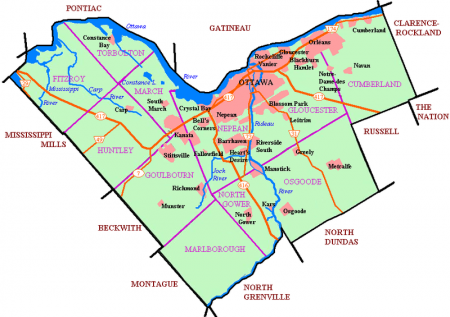Does consolidation really save tax dollars?

Map of post-2001 Ottawa showing urban area, highways, waterways, and historic townships. Map: Earl Andrew, public domain
As many New York State readers already know, the idea of consolidation keeps bobbing beside strained budgets and oceans of red ink. Surely there are savings to be found in reducing the number of municipalities and their sometimes-duplicated services?
In Ontario the same urge to reduce is called amalgamation, and quite a lot of that happened in recent years. Ottawa, for example, went from a small area that was truly at the core of the city to a massive, sprawling political unit that’s now more rural than urban, in terms of land area.
It wasn’t a choice either. In Ontario, municipalities exist (or vanish) at the behest of the province, and the government at that time wasn’t taking “no thanks” for an answer.
Gazing at any map, it certainly seemed logical to make, say, Ottawa and Nepean a single municipal unit. To the uninformed eye, there was no knowing where one left off and the other began anyway. Even so, many residents of Nepean protested mightily. After all, their city was so well-run it usually had a surplus! In contrast, Ottawa seemed more of a mess and tended to be short of funds. “It’s just a money-grab” was a complaint often heard at that time, from residents of “have” municipalities.
Having lived through that change in Ottawa myself, I could elaborate on this at length. After an initial year in Kanata, we intentionally moved to a rural municipality. Rideau Township was lovely, with reasonable taxes, good basic services – all managed by a mayor and small council mostly made up of old-timers who knew the area inside out. I certainly resented being forced to give that up.
Well, it’s been more than a dozen years since eleven historic townships were lumped into modern Ottawa in 2001. To be honest, the change presented both pros and cons. Whether the pros outweighed the cons remains a matter of opinion and study. But the basic justification – that such mergers save money – is still cause for debate.
All that is why a recent study made a splash across Ontario, particularly in Toronto and Ottawa.
According to new research by Western University professor Tim Cobban, there was a province-wide increase in many amalgamated municipal workforces. As reported by David Reevely for the Ottawa Citizen:
“I think they really overestimated the economies of scale they thought were available, especially where there were two-tier structures,” Tim Cobban said in an interview. In places like Ottawa and Toronto, which had lower-level municipalities for local duties and regional governments managing things like police and transit service, most of the tasks it made sense to share were being shared. “Those services had already migrated to a regional government.”
Cobban’s research group at Western crunched figures from municipalities across Ontario and found that from 1995 to 2010, municipalities that weren’t restructured increased their workforces by 1.77 full-time workers for every 10,000 residents. Those that were amalgamated hired 3.25 workers for every 10,000 residents.
They also compared their workforces one year before amalgamation with five years after. Ottawa went from 9,767 full-time equivalents to 12,813, an increase of nearly a third.
Now, Cobban found that a jump in municipal workers was not a hard-and-fast result. According to his figures, at the 5-year mark, Toronto’s municipal payroll was actually down by 2.7 %. But Ottawa seems to excel at hiring. Crunching the head-count numbers even further, the Citizen article says at this point Ottawa has attained a “54-per-cent increase over 14 years.”
But not so fast, says the City of Ottawa, according to this follow-up story:
His statistics are wrong, the city’s Catherine Frederick said in an email Wednesday, two days after the Citizen asked the city what it thought of Cobban’s study. In 2000, the pre-amalgamation municipalities had 12,786 full-time equivalent jobs, she wrote.
Since then, it’s true that the number of city jobs has grown to 15,134 as of end of last December. That’s an increase of 18 per cent, Frederick wrote, during a period in which Ottawa’s population has also risen by 18 per cent.

Like this “Carleton County – Yes!” sign, rural hopes to break from greater Ottawa are fading. Photo: Lucy Martin
Being part of greater Ottawa is mostly a moot point now, although a shrinking rural minority would still love to disengage. Support to at least consider de-amalgamation occasionally comes from urban city councilors who are annoyed the rural districts currently hold disproportional weight in council votes.
One still sees innumerable red and black “Carleton County – yes!” road signs scattered across rural Ottawa, a wishful cry for an all-rural district. Still, the province would have to agree to let those areas leave, and the cost of yet another shake-up seems prohibitive. De-amalgamation remains little more than a discussion point, at present.
What happened in Ontario may not translate into what’s possible, or likely, in New York. And the biggest part of the problem in Ottawa was the forced marriage of rural, mostly-conservative country dwellers with urbanites and suburbanites. At times, that’s an unhappy blend.
But, on this side of the border, some would say blithe assurances that “amalgamation saves money” were more easily made than kept.
Tags: amalgamation, canada, consolidation, economy, Ontario, Ottawa, politics, public policy





.png)


The “new” Ottawa now has with the largest percentage of rural land within its boundaries of any city in Canada. In principle, amalgamation of the urban portion of many surrounding townships in the greater Ottawa area made sense; however, too much rural land was included. Much of the rural portions of these townships should have been annexed into the rural townships further out.
Just to rock the boat, might it be a good, cost savings idea to consolidate all state governments into one United State of America government?
Think of all the money we could save by not having to pay for governors, state senators and state assembly persons.
Probably not.
Look at New York City. Once upon a time there were five counties with towns and villages within the counties. Then all five counties were consolidated into the city of New York. Now the counties are still counties but are now called boroughs. Just to make things confusing, some of the boroughs retain their county name but others have a borough name different from the county name. Bronx County is still the Borough of the Bronx but Kings County is better known as Brooklyn.
Each of the boroughs has a borough president, its own DA and numerous other locally elected officials.
Not a maven on the history of NYC but will hazard to guess the consolidation was primarily driven by transportation issues and public works.
Was money saved? That’s a bit of a crap shoot but most city residents have more to complain about taxes than the residents up here.
It is very interesting.
I think the balance between efficiency of scale, with efficiency of having a more reactive-responsive government close to the people it governs. I don’t know the answer. Certainly this is a big topic in New York both within government units and within school systems.
Historically, NY state school districts have consolidated from over 10,000 to around 670. Despite this trend we continue to face issues with costs in this state. Looking back–consolidation has not automatically resulted in cost effectiveness. Looking forward NY State must recognize that the solution is not “diesel consolidation.” It troubles me that our current Governor seems to focus upon consolidation of low enrollment, rural districts as the solution. In truth the solution is diesel delivery of course content into the low population density regions of the state. How many long bus runs with diesel costs where they are does it take to offset any savings from personnel? If consolidation is the solution the governor wishes to pursue why doesn’t he make it a priority in the regions of the state with greater population density? School districts in Nassau County average under 7 square miles per district. Westchester districts average just over ten square miles. Why isn’t there a concerted push to consolidate in those regions of the state?
I heard a story recently regarding whether consolidations of school districts in NY actually saves any money. Their snap judgment was that it did not. How do they know? There have basically not been any consolidations (save a few) so there is no data, at least not here in NYS. It may or may not save money. Didn’t we have a big consolidation in the past when we merged all those one room school houses into what we have now?
Here in Potsdam, we voted on whether or not to dissolve the Village a few years ago. It was a scary prospect in that no real savings could be predicted, and the Town government did nothing to reassure the in-Village residents. That proposal went in the direction of staying with the status quo, and our local officials all assured us that steps would be taken to consolidate services, trim budgets, and lower our tax burden. On the first of the year, our new tax bills went out, and I can’t speak for everyone, but mine went up. They went up enough for me to make emergency changes in the rents I charge, and as a result, I have lost my first tenant. There is only a tiny space between my rental income and my mortgage payment. and if an apartment isn’t filled it means big trouble.
So when will any of us see these alleged savings??